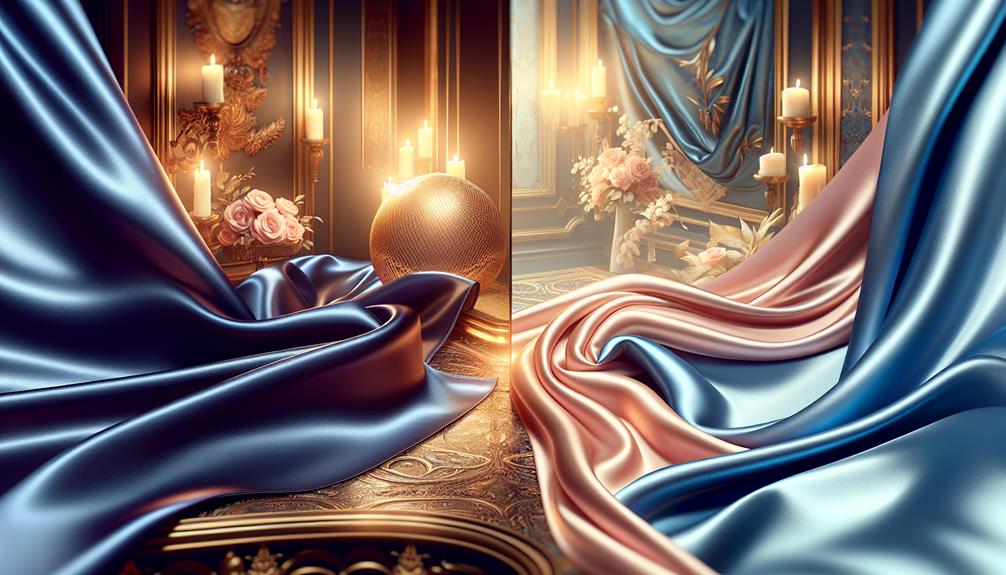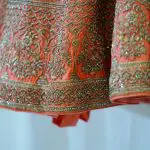I've always been intrigued by the debate over whether satin or silk is more luxurious. Personally, silk's natural charm and its rich history, dating back to ancient China, give it an edge in my book. It's not just about the material's softness or its ability to keep you cool in the summer and warm in the winter; it's also about silk's exclusivity and its environmentally friendly badge. But then again, satin's affordability and its mimicry of silk's sheen can't be ignored. So, what really sets them apart in the realm of luxury? Let's unpack this further and see if we can settle the debate once and for all.
Table of Contents
Key Takeaways
- Silk offers unmatched softness and luxury due to its natural protein fibers, making it more luxurious than satin.
- The natural sheen and elegance of silk reflect light uniquely, adding to its luxurious appeal compared to satin's synthetic gloss.
- Silk's ability to regulate temperature and provide superior breathability enhances its luxurious feel, unlike satin's weave nature.
- Silk's historical legacy and cultural significance, spanning across civilizations, contribute to its perception as more luxurious than satin.
- Choosing silk supports sustainability, adding to its luxury value, whereas satin's production involves chemicals and petroleum-based materials.
Understanding Silk
What's not to love about silk, with its natural protein fibers giving it that unmatched softness and luxury? As someone who's delved into the world of luxurious fabrics, I've found that silk's allure isn't just in its smooth texture or its lustrous sheen; it's also in the way it's made. The journey of silk begins with silkworms, and the meticulous process of unraveling and weaving these fine fibers into fabric is nothing short of fascinating. It's this painstaking craftsmanship that gives silk its luxurious feel.
Silk isn't just about looking good. Its ability to reflect light adds an elegance that few other fabrics can match. And let's not forget its versatility. Whether it's keeping you warm in the winter or cool in the summer, silk's natural fabric has you covered. However, with great luxury comes great responsibility. Silk requires a bit of extra care — think hand washing or dry cleaning — to maintain its delicate beauty.
In the realm of natural fabrics, silk stands out for its fiber quality and the unique benefits it offers. It's the epitome of luxury, combining aesthetic appeal with practicality in a way that's hard to beat.
Understanding Satin
After exploring the elegance of silk, let's now turn our attention to satin, a weave that brings its own unique set of benefits to the table. Unlike silk, which is a natural fiber, satin is a weave that can be made from a variety of materials, including synthetic fibers like nylon and polyester, wool, silk blends, or semi-synthetic fabrics such as rayon. This versatility means satin can offer the luxurious feel of silk but at a more budget-friendly price point.
Satin pillowcases, for example, are a dream for anyone looking to pamper their skin and hair while they sleep. They're super soft and smooth, reducing friction and thus minimizing the chance of waking up with frizzy hair or creased skin. This is especially great news for folks with sensitive skin, as the gentleness of satin helps protect against scratchiness.
Moreover, cleaning satin items is typically easier than silk, making them a practical choice for regular use. And when it comes to picking the perfect satin pillowcase, aiming for a thread count between 200 and 400 ensures you're getting both softness and durability, with the quality of the material being a key factor.
Production Processes Compared
So, let's talk about how these two fabrics come to be.
Silk's journey starts with the meticulous harvesting of threads from silkworm cocoons, a process that's as delicate as the fabric itself.
On the flip side, satin's creation is more straightforward, relying on machines to spin synthetic fibers into the glossy material we love.
Silk Harvesting Techniques
I'll dive into how silk is harvested, comparing the traditional sericulture technique to other production methods.
Sericulture, an age-old practice, demands feeding silkworms mulberry leaves, then harvesting the cocoons for silk. This labor-intensive process is key to silk's luxury, offering a natural fiber that's unmatched in softness and sheen.
Unlike satin, which might blend synthetic fibers like polyester or use silk in its weave, pure silk production is all about these meticulous, generation-honed techniques. The difference here is stark: silk's exclusivity comes from its complex, careful production, while satin's accessibility often leans on synthetic fibers.
Understanding this, it's clear why silk holds such a revered spot among natural fibers, its harvesting process a testament to tradition and quality.
Satin Weaving Methods
While silk's reputation is all about its complex production, let's dive into how satin's weaving methods bring its own type of luxury to the table. Unlike silk, which is a natural protein fiber, satin's glossy surface comes from its unique weave, not the material itself. This means you can get that luxurious feel across different fabric types.
| Fabric Type | Material | Characteristics |
|---|---|---|
| Cotton Satin | Cotton | Durable, less sheen |
| Polyester Satin | Polyester | Easy care, vibrant colors |
| Silk Satin | Silk Fabric | Superior moisture absorption, natural sheen |
Each type offers something special. Whether it's the durability of cotton satin, the maintenance ease of polyester, or the unmatched elegance of silk satin, there's a satin weaving method that caters to every luxury seeker out there.
Texture and Feel
Let's talk about how silk and satin feel.
I've noticed that silk's smoothness is just on another level, feeling like a gentle caress every time.
Satin's not bad, though; it's sleek but doesn't quite hit that luxurious mark silk does.
Silk Smoothness Vs. Satin
Diving into the texture and feel, silk's natural smoothness is hard to beat, but satin offers a pretty close imitation. Honestly, when it comes to feeling like royalty, silk's natural fibers just have that luxe touch that makes all the difference. Satin fabric, though, isn't too far behind with its glossy vibe. I've gotta say, for anyone chasing that opulent feel, silk is better, no contest.
| Aspect | Silk | Satin |
|---|---|---|
| Origin | Natural silkworm cocoons | Synthetic fibers |
| Texture | Unparalleled smoothness | Varies but can mimic silk |
| Feel | Luxuriously soft | Glossy and smooth |
| Luxury Level | Top-notch | Close, but not quite silk |
Comfort Level Comparison
Moving on to how they feel against the skin, silk's unmatched softness offers a level of comfort that satin struggles to meet. Let's get real, there's just something about silk that feels like a gentle hug every time it touches your skin. It's like luxury and comfort had a baby, and they named it silk.
On the flip side, satin's got its perks with a smooth surface, but it sometimes feels like it's just not quite there, you know? It's because those synthetic fibers can't quite mimic the whole vibe silk gives off. Silk's natural sheen and how it drapes just add to that feeling of being enveloped in something special.
Breathability and Comfort
When it comes to breathability and comfort, silk's natural properties give it a clear edge over satin, making it the go-to choice for a cooler and more comfortable night's sleep. Let's break it down:
- Breathability: Silk, thanks to its natural protein fiber composition, allows for superior air circulation. This means you're less likely to wake up feeling like you're in a sauna. Satin, while sleek and smooth, just can't match silk in this arena because it's a weave, not a fabric with inherent breathability.
- Temperature Regulation: Ever toss and turn because you can't find the cool side of the pillow? With silk, that struggle is minimized. Its ability to regulate temperature, keeping you cool when it's hot and vice versa, is practically a game-changer.
- Sensory Comfort: There's something about the luxurious feel of silk against your skin that just soothes the soul. It enhances comfort by promoting a soothing sensation, which is ideal for a restful night's sleep. Satin might look the part, but silk lives it.
Opting for silk over satin can significantly elevate your comfort level, thanks to its unmatched breathability and cozy vibes.
Durability and Care
While silk boasts undeniable elegance, it's a bit high-maintenance, needing gentle care, whereas satin's tough enough for a spin in the machine. Digging into durability and care, here's the deal: silk's stronger than satin but gets kinda needy when wet. You're looking at hand washing or hitting up the dry cleaner to keep it in primo condition. And hey, if you've got silk pillowcases for that hair health magic, remember to air-dry them out of the sun and stash them in something breathable.
Satin, on the other hand, is the chill cousin in the fabric family. It doesn't wrinkle as much as silk, making it easier to handle. Toss it in the washer on a gentle cycle, and you're golden. Might need a quick, low iron on the flip side, but that's about it. So, if you're all about low-maintenance but still wanna keep things looking sharp, satin's your go-to.
In the end, silk's natural strength means it could outlast satin with the right TLC, but satin's no slouch in the durability department. It's all about how much effort you're willing to put into care.
Cost Analysis
Let's get into the nitty-gritty of what you're really paying for when choosing between satin and silk.
I'm curious to see if silk's higher price tag really does offer more bang for your buck, or if satin is the underdog worth considering.
After all, everyone loves a good deal, especially when it looks as luxurious as its pricier counterpart.
Price Comparison
Diving into the cost comparison, I've noticed silk usually hits the wallet harder than satin, thanks to its fancy production and natural roots. Let's break it down:
- Silk's Premium Price: Silk, with its labor-intensive production and premium quality, is naturally more expensive. It's all about those intricate methods and its status in the market.
- Satin's Affordable Glam: Made from synthetic fibers, satin offers that luxurious look without breaking the bank. It's the go-to for those eyeing elegance on a budget.
- Cost Variation: While silk's price can swing based on type and quality, satin consistently offers an affordable alternative without compromising too much on the feel.
Value for Money
When we talk bang for your buck, silk's steep price tag often makes you wonder if it's worth the splurge over satin. Let's break it down.
Silk is like the high-end, designer brand of fabrics—luxurious, with a history of prestige. It feels amazing, but yeah, it hits the wallet hard because of its labor-intensive production.
On the flip side, satin gives you that glossy, luxe vibe without draining your bank account. It's like getting the look for less. Sure, satin's mostly synthetic, but it does a pretty decent job mimicking silk's shine and feel.
If you're after the luxurious experience without the premium cost, satin's your go-to. So, between silk's exclusivity and satin's affordability, the difference really boils down to what's worth more to you: the prestige or your pennies.
Environmental Impact
Regarding the environmental impact, silk's natural production process is way gentler on our planet than satin's chemical-heavy methods. When we're talking fabrics, the way they're made is a big deal, especially for those of us trying to live more sustainably. Silk, with its all-natural vibe, definitely takes the cake over satin in this arena.
Here's why I'm leaning towards silk:
- Silk production involves nurturing silkworms and harvesting their cocoons. It's a process that's been refined over millennia, and it's pretty much in harmony with nature.
- Satin production, on the flip side, is a whole other story. We're talking heavy use of chemicals and petroleum-based nasties, which isn't exactly what you'd call eco-friendly. This process contributes to pollution and isn't kind to our planet.
- Lastly, the fact that silk is biodegradable seals the deal for me. Knowing that my fashion choices won't linger in a landfill for centuries makes silk an outright winner.
Choosing silk over satin isn't just about luxury; it's about making a choice that's better for our environment. Plus, who doesn't love the idea of their wardrobe being as green as it's chic?
Fashion and Aesthetics
In the world of fashion and aesthetics, silk's unmatched natural sheen and elegance set it apart as the go-to material for those seeking luxury and sophistication. When we're talking about what's more luxurious, silk or satin, it's a no-brainer for me. Silk has this ultra-smooth texture and a sheen that just screams high-end. It's like the material was made to be draped over someone looking to turn heads. Plus, it feels amazing. The softness and how it kinda regulates temperature? Perfect for fashion that's not just about looking good, but feeling good too.
Now, don't get me wrong, satin's got its perks with that glossy look that kinda mimics silk. But it's usually made from synthetic fibers, which just doesn't stack up against silk's natural charm. There's something about silk that's just inherently more luxurious, probably because of its prestige and the whole cultural vibe it brings to the table.
Historical Significance
Moving beyond just the look and feel, let's talk about how silk's rich history adds to its allure. For over two millennia, Chinese silk production was this epic secret no one else could crack, making it insanely coveted across continents. Now, that's got to add a layer of mystique to silk that satin just can't match, right? Here's why the historical significance of silk really sets it apart:
- Roots in Antiquity: Silk's origins dig deep back to ancient Chinese textile traditions. We're talking about a legacy that has influenced fashion and trade worldwide.
- Symbol of Luxury: Throughout history, silk wasn't just a fabric; it was a marker of wealth and sophistication. Its prestige has never really waned, keeping it at the top of the luxury ladder.
- Cultural Impact: Silk's historical journey from East to West has left a lasting impact on cultures and economies around the globe. This isn't just about a textile; it's about a story that continues to unfold.
While satin has its perks, it lacks the profound historical significance and cultural depth that silk boasts. It's this rich backdrop that truly elevates silk in the realm of luxury and sophistication.
The Verdict: Luxury Defined
So, when we stack silk against satin in the luxury showdown, silk clearly takes the crown for its unmatched elegance and rich history. It's not just about how they look or feel; it boils down to silk being a natural marvel, spun from silkworm cocoons, giving it a legacy of luxury that's hard to beat. The thing is, silk isn't just about looking good. It's breathable, wicks moisture like a champ, and is surprisingly tough for something so delicately smooth. That's a combo you won't find in many materials, luxurious or otherwise.
Now, don't get me wrong, satin's got its perks with that glossy finish and smooth touch. But since it often comes from synthetic fibers, it lacks that natural richness that makes silk stand apart. There's something about silk's natural sheen and soft texture that satin, with all its shine, just can't mimic. Plus, the effort that goes into making silk, from unraveling those tiny fibers to weaving them into the luxurious fabric we love, adds a layer of prestige that satin struggles to match. In the world of luxury, silk's natural elegance and rich backstory make it the clear winner over satin's synthetic shine.
Frequently Asked Questions
What's More Expensive Silk or Satin?
I've found that silk is usually pricier than satin. It's because silk's natural and needs a lot of effort to make. Satin can look fancy too, but it's often cheaper since it's synthetic.
Is Silk Higher Quality Than Satin?
I've learned that silk is indeed higher quality than satin. Its natural origin, labor-intensive production, and unique properties like breathability and softness set it apart. Silk's luxury and quality surpass satin's synthetic appeal.
Is Satin a Luxury Fabric?
Absolutely, satin's considered a luxury fabric. Its smooth, glossy look and soft feel scream high-end. It's why you see it in fancy bedding and fashion. The sheen and comfort level definitely place it in the luxury category.
Which Lasts Longer Silk or Satin?
I've found that silk lasts longer than satin. Its natural strength means it doesn't stretch or tear as easily. While both need careful maintenance, investing in quality silk pieces really pays off in durability.
- 15 Creative Projects You Can Make With Poly-Cotton Fabric - June 23, 2025
- The Cost-Effectiveness of Cotton Polyester Fabric Explained - June 23, 2025
- Is Cotton Polyester Fabric Absorbent? A Guide for Sportswear - June 23, 2025







